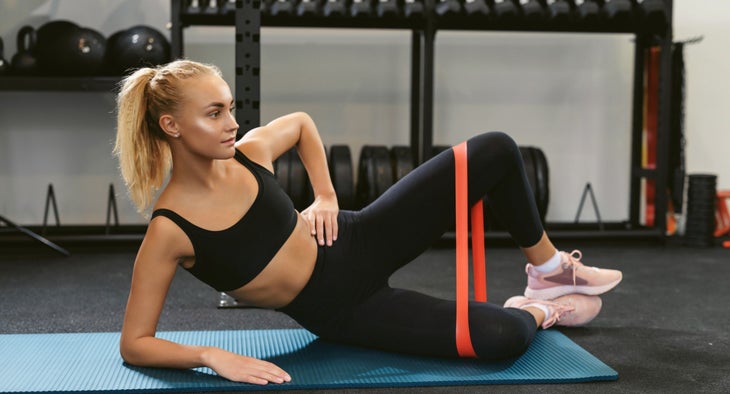Heading out the door? Read this article on the new Outside+ app available now on iOS devices for members! Download the app.
These days, who doesn’t want to grow their glutes — or at the very least, walk out of the gym with a “booty lift”? Plus, there are so many good reasons to train your glutes aside from looks. If the focus of your workouts has been to increase glute activation, not only for aesthetics but for injury prevention, you’re in the right place.
As an increasingly sedentary population, our backsides have become lazy (for lack of a better term) thanks to a decrease in activities that require us to move around and stand. For many, this will be a direct path to back pain because glute muscles act as stabilizers for the pelvis, core, and lower body. Without that stabilization, there’s potential for excessive lumbar movement and in turn, back issues as the back muscles try (and fail) to fully compensate for sleepy glutes.
The glutes are also the largest muscle we have and can make a world of difference in our overall health when utilized properly. Let’s talk more about how we can build glute strength — and the mistakes to avoid along the way.
6 Mistakes You’re Probably Making in Your Glute Workouts
1. You’re Only Moving in One Plane
Runners commonly fall victim to this glute-training misstep, but they aren’t the only ones guilty of this. Many programs don’t focus on the importance of moving in all directions other than just forward and backward the way you do while running — but movement in the sagittal plane is just as crucial. Performing exercises such as curtsy lunges, lateral step-overs, lateral banded walks, and coccyx (side-to-side) squats will develop the deep muscle fibers of your glutes such as the gluteus medius and minimus. Multi-planar motion is also much more functional when it comes to our everyday lives.
2. You’re Moving too Quickly Through Reps
Increasing time under tension, or the amount of time a muscle group is under stress, is an excellent way to maximize muscle growth. Rushing through reps will leave your muscles missing out on the benefits of this. Think about adding a one- or two-second pause at the top of the rep when performing a hip thrust or adding a one-second pause at the bottom of your single-leg split squat.
With these reps, try to maintain a steady tempo throughout the rep, but spend more time in the eccentric, or “lowering down” portion of the exercise. (Think about the “lowering down” portion of a squat as you descend — that’s the eccentric portion). Be sure to focus on form here, as longer reps and increased stamina demands can cause form to break down.
3. You’re Not Lifting Heavy Enough
If you want muscle growth to occur, muscle breakdown is necessary. Therefore, progressive overload must occur. If you don’t feel that classic day-after soreness or even more so that second-day soreness, you may not be pushing yourself hard enough with the weights you’re choosing.
Obviously, good form always comes before load. First, focus on form and dial in good movement patterns before adding weight. Once you have these down, begin to increase the load so that those last few reps in a set are challenging. Implement the theory of progressive overload — gradually increasing the weight or number of reps as you progress — through your training routine.
4. You’re Not Doing Hip Thrusts
I’ve written about this exercise before and quite honestly, I cannot get enough of it. This is by and large the best glute developer and natural booty lifter that exists. I already addressed this above, but our glutes stabilize our pelvis, core, and lower body. Muscles are designed to work in pairs, and the hip flexors are the antagonist (partner) muscle to the glutes. The glutes work to extend the hip while the hip flexors, as their name implies, work to flex the hip.
If your hip flexors are stronger than your glutes, they can pull your pelvis into poor alignment, causing pain and other postural problems. The hip thrust improves your glute strength through hip extension when done properly. Make sure you work with a coach who can help you fine-tune your form to execute this movement safely and efficiently.

5. You’re Not Doing Enough Unilateral Work
Unilateral (one side at a time) glute work is an excellent way to train your non-dominant side. Examples of single-leg work include single-leg glute bridges, step-ups, split squats, lunges and single-leg RDLs. Adding exercises like this into your training program can address weaker or less commonly active muscles through isolation. Muscle imbalances can lead to injury down the road due to compensation if left unaddressed.
6. You’re Not Doing Enough Isolation Exercises
Functional strength training is the fastest way to make gains, but that doesn’t mean there isn’t a time and a place for isolation exercises. Adding some isolation exercises into your programming will help you zero in on your glutes. This is especially true for someone who sits a lot and isn’t feeling their glutes fire during compound movements such as the back squat, single-leg RDL, and so on.
If you feel most of your glute exercises in your lower back and your hamstrings, you should try some isolation sets. Some that I like include the prone hip extension, banded glute bridges, donkey kicks, fire hydrants, 3-way hip circles and reverse clamshells.